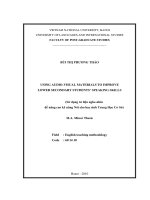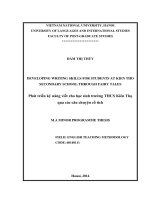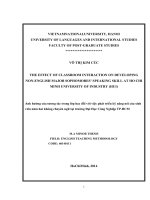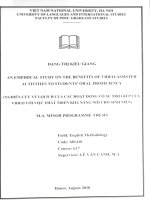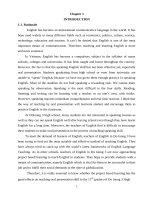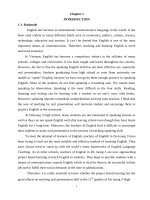developing students’ speaking skill through project- based learning = phát triển kỹ năng nói cho học sinh qua việc học theo dự án
Bạn đang xem bản rút gọn của tài liệu. Xem và tải ngay bản đầy đủ của tài liệu tại đây (519.15 KB, 55 trang )
VIETNAM NATIONAL UNIVERSITY, HANOI
UNIVERSITY OF LANGUAGES AND INTERNATIONAL STUDIES
FACULTY OF POST GRADUATE STUDIES
*****************
PHẠM THỊ THU HÀ
DEVELOPING STUDENTS’ SPEAKING SKILL THROUGH
PROJECT-BASED LEARNING
PHÁT TRIỂN KỸ NĂNG NÓI CHO HỌC SINH
QUA VIỆC HỌC THEO DỰ ÁN
M.A. MINOR PROGRAMME THESIS
Field: English Teaching Methodology
Code: 60140111
HANOI - 2014
VIETNAM NATIONAL UNIVERSITY, HANOI
UNIVERSITY OF LANGUAGES AND INTERNATIONAL STUDIES
FACULTY OF POST GRADUATE STUDIES
*****************
PHẠM THỊ THU HÀ
DEVELOPING STUDENTS’ SPEAKING SKILL THROUGH
PROJECT-BASED LEARNING
PHÁT TRIỂN KỸ NĂNG NÓI CHO HỌC SINH
QUA VIỆC HỌC THEO DỰ ÁN
M.A. MINOR PROGRAMME THESIS
Field: English Teaching Methodology
Code: 60140111
Supervisor: Ph.D. TÔ THỊ THU HƯƠNG
HANOI - 2014
i
DECLARATION
I hereby, certify the thesis named “Developing students’ speaking through
Project-Based Learning is the result of my own work for the Minor Degree of
Master of Arts at University of Languages and International Studies, Vietnam
National University, Hanoi. The research has not been submitted for any degree at
any other universities or institutions. I agree that the origin of my thesis deposited in
the library can be accessible for the purposes of study and research.
Hanoi-2014
Phạm Thị Thu Hà
ii
ABSTRACT
In an attempt to develop English speaking skill for tenth-grade students at An Lao
High School by using Project Based Learning, this research addressed two issues: (1)
students’ attitudes toward the use of Project Based Learning in their English lessons; (2)
the impacts of using PBL on students’ English speaking. The instruments employed for
data collection and analysis of the study included two tests and two questionnaires for the
students, an interview with two teachers and the teacher’s journals. Research findings
showed that the students had positive attitudes towards the use of PBL in their English
lessons. It was also revealed that PBL was beneficial to help students improve their
performance in speaking lessons. Based on the findings, some implications would be given
for both the teacher and the students. With all these information, this study is expected to
be useful to both teachers and students in teaching and learning English speaking skill.
iii
ACKNOWLEDGEMENTS
First of all, I would like to express my deepest thanks to Dr. Tô Thị Thu Hương,
my supervisor, for her invaluable support, guidance, and constructive comments. Without
her assistance and encouragement, this study would not have been accomplished.
I am also indebted to all of my lecturers at Post-Graduate Department for their
valuable lectures on the aspects of my concern.
Finally, I would like to show my sincere thanks to all the authors listed in the
references for their ideas in this field. They have developed my thinking on doing this
paper.
iv
LIST OF ABBREVIATIONS AND SYMBOLS
%
CEFR
CLT
PBL
Ss
T
Percent
Common European Framework of Reference for Languages
Communicative Language Teaching Approach
Project- Based Learning
Students
Teacher
LIST OF CHARTS AND TABLES
Chart 1: Using PBL has helped develop your English speaking skill
Table 1: Table 1: How is the grade calculated? ……………………
Table 2: The results of the pre-test…………………………………
Table 3: The results of the questionnaire concerning causes of the
students’ low English proficiency …………………………………
Table 4: The results of the post-test …………………………………
Table 5: Students’ opinion of the optional lessons using Project-
Based Learning ……………………………………………………….
Table 6: The criteria of speaking skill have been improved by the
students………………………………………………………………
Table 7: Ss’ changes after taking part in the lessons using PBL……
Table 8: The difficulties students encountered when carrying out
their projects…………………………………………………………
34
14
14
15
32
34
35
36
37
v
TABLE OF CONTENTS
Declaration i
Abstract ii
Acknowledgements iii
List of abbreviations and symbols iv
List of charts, figures and tables iv
Table of contents v
PART A: INTRODUCTION 1
1. Rationale of the research 1
2. Aims of the research 2
3. Scope of the research 2
4. Research questions 2
5. Methodology 2
5.1. Definition 2
5.2. Reason for the use of action research. 3
5.3. Action research design 3
5.4. Participants 4
5.5. Procedures 4
PART B: DEVELOPMENT 6
CHAPTER I: THEORETICAL BACKGROUND 6
1.1. Speaking skill 6
1.1.1. Definition of speaking 6
1.1.2. Functions of speaking 6
1.1.3. The importance of teaching speaking skill 7
1.2. Communicative Language Teaching 7
1.3. Project – Based Learning 9
1.3.1. Definitions of Project-Based Learning 9
1.3.2. Key features of Project- Based Learning 10
1.3.3. Teacher’s role in Project- Based Learning 11
1.3.4. Stages in project work 11
1.3.4.1. Stage 1: Speculation 11
1.3.4.2. Stage 2: Designing the project activities 11
vi
1.3.4.3. Stage 3: Conducting the project activities 12
1.3.4. 4. Stage 4: Evaluation 12
CHAPTER II: THE STUDY 13
2.1. Research questions and design 13
2.2. Planning stage 13
2.2.1. The problem 13
2.2.2. Evaluation of the students' speaking skill through a pre-test 13
2.2.3. Conducting a questionnaire to get information from students 15
2.2.4. Drawing a plan of action to solve the problems 16
2.3. Acting stage 17
2.3.1. Theme 1: Conservation 17
2.3.2. Theme 2: Music 18
2.3.3.Theme 3: Cities 20
2.3. 4. Theme 4: Historical Places 21
2.4. Observing stage 22
2.4.1. Brief description of the first lesson with theme “Conservation” 22
2.4.2. Brief description of the first lesson with theme “Music” 25
2.4.3. Brief description of the first lesson with theme “Cities” 27
2.4.4. Brief description of the first lesson with theme “Historical Places” 29
2.5 Evaluation stage 31
2.5.1 Evaluation of the students' speaking skill through a post-test 31
2.5.2. Evaluation of the students' speaking skill through the results of the interview with
two teachers 33
2.5.3 Evaluation of the students' speaking skill through the results of the questionnaire with
students 34
PART C: CONCLUSION 39
1. Recapitulation 39
2.Conclusions 39
3. Limitations and suggestions for further research 40
4. Implications for developing speaking skill through Project Based Learning 41
REFERENCES 42
APPENDICES I
1
PART A: INTRODUCTION
1. Rational of the research
Realizing that foreign language proficiency is really essential for students in
an increasingly connected world, in Vietnam, Ministry of Education and Training
has put more emphasis on teaching and learning foreign languages, especially
English than ever before. It is the Vietnam’s National Foreign Language 2020
Project that is a milestone in improving teaching and learning foreign languages.
With the recognition of the importance of developing language skills for
students, AnLao High School has implemented the seven year system course books
- English 10, 11, 12 to help students to master four English language skills.
Experiencing seven years teaching these course books, the researcher encountered
quite a few problems in terms of the low English proficiency of the students in
speaking skill. Students got into a lot of difficulties in speaking English, and the
most serious problem was the lack of confidence. Consequently, students had
limited success in developing English speaking skill. Problems relating to the
contents of a speech like ideas and grammar were the second and third most
common. Students usually had little idea about what to say and they might be even
unsure how to use the correct grammar. Besides, pronunciation was another major
obstacle. This fact confirms the following opinion, “The acquisition of good
pronunciation…is commonly held to be the most difficult of all tasks in second
language learning” (Carrasquillo, 1994, p.136).
The researcher considered the use of Project-Based Learning as an
appropriate strategy to help the students overcome all the difficulties in developing
speaking English because PBL goes on over a period of time, resulting in products
and presentations in which some aspects of speaking as confidence, ideas, grammar,
and pronunciation can be enhanced by students. Moreover, students can foster the
development of other skills such as collaboration, critical thinking, and problem
solving through each project.
Considering the positive contributions of PBL, the researcher conducted a
2
study on the implementation of Project-Based Learning (PBL) to develop the
English speaking skill for the tenth- grade students at An Lao High School.
2. Aims of the research
The research aims to:
- find out the tenth- grade students’ attitudes towards the use of Project-Based
Learning in their optional English lessons.
- discover how the use of Project-Based Learning in teaching English helps
develop students’ English speaking skill.
3. Scope of the research
The research focused on using Project-Based Learning in teaching English in
optional English lessons to the tenth-grade students at AnLao High School in the
second term of the school-year of 2013-2014.
4. Research questions
1. How can the use of Project-Based Learning in teaching English help
develop AnLao tenth-grade students’ English speaking skill?
2. What are the attitudes of AnLao tenth-grade students towards the use of
Project- Based Learning in their optional English lessons?
5. Methods of the research
It was action research with mixed methods for data collection that became
the methodology of the research. The tools for data capture involved two
questionnaires for students, an interview with teachers, a pre-test, a post-test, class
observation and teachers’ journals.
5.1 Definition
Action research, according to Parsons and Brown (2002) is a form of
investigation designed for use by teachers to attempt to solve problems and improve
professional practices in their own classrooms. It involves systematic observations
and data collection which can be then used by the practitioner-researcher in
reflection, decision-making and the development of more effective classroom
strategies.
3
5.2 Reason for the use of action research.
It is necessary to do research into what is actually happening in classrooms to
improve teaching and learning practices. Knowing what exactly is happening in
classes can help teachers focus on aspects of teaching which are beneficial to their
students.
This research addressed my own problems in my teaching English speaking
skill, and therefore it provided my students with better opportunities to develop their
English speaking skill.
5.3 Action research design
There are four key stages in the action research including Planning, Acting,
Observing and Evaluation.
Stage 1: Planning:
- Problems and causes of the students’ low English proficiency in speaking skill
were explored through a pre-test and a questionnaire. The students at AnLao High
School were faced with some problems when speaking English including bad
pronunciation, lack of vocabulary, fear of mistakes and fear of speaking in public.
These problems were mostly due to ineffective methods and techniques employed
by the teachers of English of AnLao High School.
- Strategies for improvement were mapped out through lesson plans applied PBL in
English teaching to develop the students' English speaking skill.
Stage 2: Acting
- PBL was adopted to improve their English speaking skill in 16 optional lessons of
an English intensive class 10C9 in the second term of the school-year of 2013-2014
with 4 themes based on English 10.
Stage 3: Observing
- Two volunteer teachers were asked to observe those lessons and evaluate the
changes in AnLao tenth-grade students’ English speaking skill.
4
- Class observations were made carefully by the teacher and the success of the
action research on using PBL to develop student's English speaking skill lay in the
outcomes of the class observations.
Stage 4: Evaluation
- A post-test was given to the students to evaluate their improvement in speaking
skill.
- An interview and a questionnaire were carried out to get information from teachers
and students on the efficiency of the use of PBL in developing English speaking
skill.
- From the results of the post-test, the interview and the questionnaire, some
conclusions were made.
5.4 Participants
The research was conducted with the participation of 40 tenth - grade students
of the English intensive class and 2 teachers of AnLao High School during the
second term of the academic year 2013-2014 at AnLao High School.
5.5 Procedures
- At the end of the first term of the academic year 2013-2014, an evaluation of the
students’ English speaking ability, a pre-test was administered. The criteria for
evaluating each student’s speaking ability in the pre-test include fluency and
coherence, lexical resource, grammatical range and accuracy, pronunciation, and
interactive communication.
- The researcher planned 4 lessons with 4 themes applied the use of PBL in English
teaching to motivate the students to learn English and to develop their speaking skill.
- PBL was carried out in accordance with the lesson plans within 16 weeks and
what happened in the class with 40 students was recorded in the teacher’s journals.
- Two teachers were asked to observe those lessons and evaluate the changes in the
students’ English speaking skill.
5
- The results of class observation were used to evaluate the success of the action
research on using PBL to develop student's English speaking skill.
- A speaking post-test was conducted to find out the efficiency of the use of PBL in
developing English speaking for the students.
- An interview and a questionnaire were carried out to get information from
teachers and students on the efficiency of the use of PBL in developing tenth
graders’ English speaking skill.
- Based on data from student questionnaires, teacher interview, class observations,
teacher journals, and the results of a pre-test and post-test, the researcher made an
in-depth quantitative and qualitative analysis towards the two themes stated in the
two research questions.
- Then the research was put down in writing.
6
PART B: DEVELOPMENT
CHAPTER I: THEORETICAL BACKGROUND OF THE
RESEARCH
This chapter briefly presents the literature on speaking skill, Communicative
Language Teaching Approach and Project-Based Learning. Besides, it also
describes how Project-Based Learning helps develop students’ speaking skill in
classroom.
1.1 Speaking skill
1.1.1 Definition of speaking
“Speaking is an interactive process of constructing meaning that involves
producing, receiving and processing information. Its form and meaning are
depending on the context in which it occurs, including the participants
themselves, their experiences, the physical environment, and the purposes for
speaking. It is often spontaneous, open-ended, and evolving. However,
speech is not always unpredictable. Speaking requires that learners not only
know how to produce specific points of language such as grammar,
pronunciation, or vocabulary ("linguistic competence"), but also that they
understand when, why, and in what ways to produce language
("sociolinguistic competence").” (Nunan, 1999:216)
1.1.2 Functions of speaking
According to Jack C. Richards (2008:21), in order to achieve a
communicative goal through speaking, there are three functions of speaking to be
considered – talk as interaction, talk as transaction, and talk as performance. Each
of these speech activities is quite distinct in terms of form and function and requires
different teaching approaches.
• “Talk as interaction refers to what we normally mean by “conversation” and
describes interaction that serves a primarily social function.”
7
• “Talk as transaction refers to situations where the focus is on what is said or
done. The message and making oneself understood clearly and accurately is
the central focus, rather than the participants and how they interact socially
with each other.”
• “Talk as performance refers to public talk, that is, talk that transmits
information before an audience, such as class room presentations, public
announcement, and speeches.”
Three core issues need to be addressed in planning speaking activities for an
English class, and the researcher found that PBL was really an opportunity for
students to acquire all kinds of talk.
1.1.3 The importance of teaching speaking skill
Teaching speaking is a very important part of second language learning. The
ability to communicate in a second language clearly and efficiently contributes to
the success of students in school and success later in every phase of life. Therefore,
it is essential that language teachers pay great attention to teaching speaking. Rather
than leading students to pure memorization, providing a rich environment where
meaningful communication takes place is desired. With this aim, PBL can
contribute a great deal to students in terms of acquiring the three functions of
speaking. Besides, PBL helps develop basic skills necessary for life. Those
activities at PBL make students more active in the learning process and at the same
time make their learning more meaningful and fun.
1.2 Communicative Language Teaching Approach (CLT)
The history of language learning and teaching methods has experienced
many changes with many approaches such as Grammar - Translation Method,
Audio lingual Method, the Total Physical Response, the Natural Approach, and, etc.
CLT is the latest influence on teaching methodology which has been put forth
around the world as an innovative approach to teach English as a second or foreign
language.
* Nunan' s definition of CLT:
8
“CLT views language as a system for the expression of meaning. Activities
involve oral communication, carrying out meaningful tasks and using
language that is meaningful to learners. Objectives reflect the need of the
learners: they include functional skills as well as linguistic objectives. The
learners’ role is as a negotiator and integrator. The teachers’ role is as a
facilitator of the communication process. Materials promote communicative
language use; they are task – based and authentic.” (Nunan, D, 1989:194)
* Characteristics of CLT:
Nunan, D (1991:279) offered five characteristic features of CLT:
• The introduction of authentic texts into the learning situation.
• An emphasis on learning to communicate through interaction in the target
language.
• The provision of opportunities for learners to focus not only on language
but also on the learning process itself.
• An enhancement of the learners‟ own experience as important contributing
elements to classroom learning.
• An attempt to link classroom language with language activation outside the
classroom.
The English text book for grade 10 follows this dominating approach. It was
designed with a view to developing students’ communicative skills at basic level:
speaking, listening, reading and writing as well as providing students with
appropriate, systematic and basic knowledge of English. With this approach, the
need for communicative proficiency is focused on rather than mere mastery of
structures. However, those activities in English 10 did not meet the demand of
communicative proficiency. Then, the researcher used PBL, and found that it was
really a good teaching practice to help students develop their communicative
competence.
9
1.3 Project-Based Learning
1.3.1 Definitions of Project-Based Learning
Haines (1989:1) defines PBL in the following quote:
“… [Projects are] multi-skill activities focusing on topics or themes rather
than on specific language targets. Of crucial importance is the part which the
students themselves play in the initial choice of subject matter and in the
decisions related to appropriate working methods, the project timetable and
the eventual “end product”. Because specific language aims are not
prescribed, and because students concentrate their efforts and attention on
reaching an agreed goal, project work provides students with opportunities to
recycle known language and skills in a relatively natural context. Projects
can be intensive activities which take place over a short period of time, or
extended studies which may take up one or two hours a week for several
weeks”.
Skehan (1998:273) characterizes PBL in the following quote:
“Project work enables the gradual development of autonomy with
progressively greater responsibility being taken by the learners… [Project
work] is an excellent structure for preparing learners to approach learning in
their own way, suitable to their own abilities, styles and preferences”.
Another quote that summarizes PBL is from Fried-Booth (2002:6),
“Project work is student-centered and driven by the need to create an end-
product. However, it is the route to achieving this end-product that makes
project work so worthwhile. The route to the end-product brings
opportunities for students to develop their confidence and independence and
to work together in a real-world environment by collaborating on a task”.
A clearer picture of PBL from the above definitions is that Project-Based Learning
is engaging learning experiences that involve students in complex, real-world
projects through which they develop and apply skills and knowledge. The outcomes
10
can be identified up front but sometimes are only experiences to allocate resources
such as time or materials.
1.3.2 Key features of Project-Based Learning
There are 6 key features of Project-Based Learning offered by Stoller’s (2007:4-5).
These are as follows:
1. Project work focuses on content learning rather than on specific language
targets. Real-world subject matter and topics of interest to students can
become central to projects.
2. Project work is student-centered, though the teacher plays a major role in
offering support and guidance throughout the process.
3. Project work is cooperative rather than competitive. Students can work on
their own, in small groups, or as a class to complete a project, sharing
resources, ideas, and expertise along the way.
4. Project work leads to the authentic integration of skills and processing of
information from varied sources, mirroring real-life tasks.
5. Project work culminates in an end product (e.g., an oral presentation, a
poster session, a bulletin board display, a report, or a stage performance)
that can be shared with others, giving the project a real purpose. The value
of the project, however, lies not just in the final product but in the process of
working towards the end point. Thus, project work has both a process and
product orientation, and provides students with opportunities to focus on
fluency and accuracy at different project-work stages.
6. Project work is potentially motivating, stimulating, empowering, and
challenging. It usually results in building student confidence, self-esteem,
and autonomy as well as improving students’ language skills, content
learning, and cognitive abilities.
From the features of PBL, a wide range of benefits to both students and teachers are
further clarified. A growing body of academic research supports the use of project-
based learning in school to engage students, cut absenteeism, boost cooperative
11
learning skills, and improve academic performance (George Lucas Educational
Foundation, 2001).
For many students, the appeal of this learning style comes from the
authenticity of the experience. Students take on the role and behavior of those
working in a particular discipline. Whether they are making a documentary video
about an environmental concern, designing a travel brochure to highlight sites of
historical significance in their community, or developing a multimedia presentation
about their interests, students are engaged in real-world activities that have
significance beyond the classroom.
For teachers, additional benefits include enhanced professionalism and
collaboration among colleagues, and opportunities to build relationships with
students (Thomas, 2000). Additionally, many teachers are pleased to find a model
that accommodates diverse learners by introducing a wider range of learning
opportunities into the classroom.
1.3.3 Teacher's role in Project-Based learning
Effective Project-Based Learning requires the teacher to assume a different
role (Levy,1997). The teacher’s role is not dominant, but he/she acts as a guide,
advisor, coordinator (Papandreou, 1994), and facilitator. In other words, in
implementing the project method, the focal point of the learning process moves
from the teacher to the learners, from working alone to working in groups.
1.3.4 Stages in project work
1.3.4.1 Stage 1: Speculation
This stage includes choice of project topic and sensitisation about it, aiming
at arousing interest and developing a climate conducive to speculation and
investigation that will lead smoothly to the research process. Topic is chosen after a
dialogue among all members of the group, and the teacher (Brinia, 2006).
1.3.4.2 Stage 2: Designing the project activities
This stage includes formation of groups and assigning of roles, decisions
concerning methodology, sources of information, activities that will take place, and
12
places outside the classroom that students will visit. The better organised and more
analytical the structuring of the activities, the easier and faster the research will be
conducted (Fragoulis, 2008).
1.3.4.3 Stage 3: Conducting the project activities
At this stage the groups implement the activities designed in the previous
stage. Students gather information, process and categorize it. If deemed necessary,
there may be intervals of information and feedback, in which students discuss issues
related with cooperation among group members, problems of personal relations, and
possible changes in group composition.
The next phase is synthesis and processing of information gathered. The final
products are displayed in the class and become a stimulus for thought and action for
other students (Fragoulis, 2008).
1.3.4.4 Stage 4: Evaluation
Evaluation refers to the assessment of the activities from participants and
discussion about whether the initial aims and goals have been achieved,
implementation of the process, and final products (Brinia, 2006). Evaluation also
entails assessment of errors and problems in the presentations of the final products.
Although there are many studies focusing on theories for Project-Based
Learning in foreign language teaching, there are relatively few empirical studies
linking theory with practice, evaluating the impact of project work in the context of
foreign language instruction. In this context, the purpose of my research is to study
the practical aspects of implementing project work in High School settings,
reporting difficulties encountered, benefits from project work, and pedagogical
implications.
13
CHAPTER II - THE STUDY
2.1. Research questions and design
The research was conducted to find answers to the two following questions:
1. What are the attitudes of AnLao tenth-grade students towards the use of
Project Based Learning in their optional English lessons?
2. How can the use of Project Based Learning in teaching English help
develop AnLao tenth-grade students’ English speaking skill?
The action research went through four stages which are described in detail as
follows.
2.2 Planning stage
STEP 1: EXPLORING THE PROBLEMS
2.2.1 The problems
In English speaking lessons, the researcher found that the students were quite
passive in their learning. In other words, they did not contribute actively to the
speaking lessons and they often kept quite. Most of the students are lacking in
contents and confidence when speaking English. As a result, the students’ speaking
ability was not good.
2.2.2 Evaluation of the students' speaking skill through a pre-test .
According to Vietnam’s National Foreign Language 2020 Project, tenth-
grade students are supposed to achieve CEFR level A2, so a pre-test was conducted
to evaluate the students’ speaking skill. The pre-test took place in pairs among
students and met the CEFR's demands at A2 level.
The pre-test (WBT) consists of three parts:
Part 1: Getting to know each other
- Can you tell me something about yourself? (name, age, languages, hobbies, )
- The teacher will ask you one or two more questions about yourself.
Part 2: Exchanging information
- Talk to your partner about two or three of the following topics. Ask questions.
* Your favorite food
14
* Your home
* Your pet
* Your last holiday
* Your plans next weekend
Part 3: Consensus finding
You and your partner want to spend next Saturday together.
- What would you like to do?
- Suggest something!
- Give reasons!
- Agree on one activity. When do you want to do them?
(go to the country, go to the zoo, go shopping, go to a concert, go jogging )
The speaking test is also marked out of 10 according to the following criteria:
* Fluency and coherence (2 points)
* Lexical resource (2 points)
* Grammatical range and accuracy (2 points)
* Pronunciation (2 points)
* Interactive communication (2 points)
Table 1: How is the grade calculated?
9-10 points
Very good
8-8.9 points
Good
6-7.9 points
Satisfactory
5- 5.9
Pass
The author observed and graded, but these criteria do not meet expectations.
The following table below will show the results of 40 students.
Table 2: The results of the pre-test
Grade
Very good
Good
Satisfactory
Pass
Not pass
Number of
students
0
0
4
12
24
15
The table shows the students' English speaking ability. No students achieved
grade "very good" or "good". There were only 4 students (made up 10%) who
achieved grade "satisfactory", 30% achieved grade "pass" and 60% do not meet
expectations.
It can be seen from the results of the pre-test that the students' English
speaking ability was not good. Almost these criteria did not meet expectations.
Therefore, in the next step, the author conducted a questionnaire to find out the
causes of the students’ low speaking ability.
STEP 2: IDENTIFYING CAUSES OF THE PROBLEMS
2.2.3 Conducting a questionnaire to get information from students
40 students were asked to give their answers to 5 questions in English
prepared by the researcher and then handed their papers to the researcher for
analysis (see APPENDIX 1).
Table 3: The results of the questionnaire concerning causes of the
students’ low English proficiency
Questions
Responses
Number of
students (%)
a. Are you afraid of speaking
English in front of the class?
Yes
36 (90%)
No
4 (10%)
b. What are the reasons why you
are afraid of speaking English in
front of the class?
bad pronunciation
31 (77.5%)
lack of vocabulary
27 (67.5%)
fear of mistakes
29 (72.5%)
fear of other people's opinions
17 (42.5%)
fear of speaking in public
36 (90%)
c. What do you think of the
speaking activities in English
speaking lessons?
boring
27 (67.5%)
interesting
13 (32.5%)
d. Do you work in groups actively
in the English speaking lessons?
Yes
11 (27.5%)
No
29 (72.5%)
16
e. How often do you practice
speaking English in front of the
class?
usually
12 (30%)
sometimes
23 (57.5%)
rarely
5 (12.5%)
It can have four conclusions drawn from the results of the questionnaire.
1. Almost students are afraid of speaking English in front of the class because of
bad pronunciation, for fear of lack of vocabulary, mistakes and speaking in public.
2. The speaking activities in the English speaking lessons are not really interesting
to motivate students to practice speaking English.
3. Students do not work in groups actively in the English speaking lessons.
4. Students do not have many chances to practice English in front of the class.
Most of the problems leading to the low English proficiency of the students
in speaking skill belong to the teacher’s responsibilities. Thus, it is necessary that
the teacher design strategies for the students’ improvement in speaking skill.
STEP 3: MAPPING OUT STRATEGIES FOR IMPROVEMENT
2.2.4. Drawing a plan of action to solve the problems
To solve the problems, I worked out several alternative ways which could be
applied in this context to improve the students’ speaking skill and gave them
opportunity to work independently and responsibly. They were role-play activity,
discussion activity, information-gap activities, project-based learning Finally, I
decided to choose Project-Based Learning as an appropriate learning activity to help
me solve all the problems.
I designed the following strategies to improve the problems:
1. Students chose the group members at the end of the first term.
2. The teacher provided a list of topics based on the themes of English 10 from Unit
8 to Unit 16. (The Story Of My Village, Undersea World, Conservation, National
Parks, Music, Film And Cinema, The World Cup, Cities, Historical Places).
3. Students chose four most interesting themes to conduct projects including
Conservation, Music, Cities and Historical Places which were carried out in 16
17
optional periods (four weeks for one theme).
3. Forty students were divided into 8 groups. Every four weeks, each group carried
out their project with four stages of Project-Based Learning.
4. Each group made a presentation on their project in about 15 minutes. There were
2 groups presenting each week and 15 minutes rest of each period were spent on
asking and answering questions and discussion. Students were also given a chance
to make comments on their friends’ projects and presentations. During the
presentations, they acted as audience, observers and assessors. Finally, teacher’s
constructive feedback on the presentations and the projects played a very important
role so that students could improve their speaking skill.
2.3 Acting stage
STEP 4: IMPLEMENTING STRATEGIES AND TEACHER’S JOURNALS
ON WHAT HAPPENED IN THE CLASS
The strategies were adopted in sixteen optional periods. All of the
improvements after each lesson were noted down by the teacher in the journal.
2.3.1 Theme 1: Conservation
* AIMS: By the end of the four lessons, the students will be able to obtain:
- General knowledge: some information about environmental issues.
- Vocabulary: words related to environmental issues.
- Skills: speaking skill - presenting on one environmental issue that needs to be
conserved.
* MATERIALS: projector, laptop, a documentary video about an environmental
concern.
* ANTICIPATED PROBLEMS:
- The students may have difficulty in making a documentary video and processing
information.
- They may less confident in presenting information in front of the class.
* STAGES:
T introduces eight environmental issues that need to be conserved: Energy, Water,


